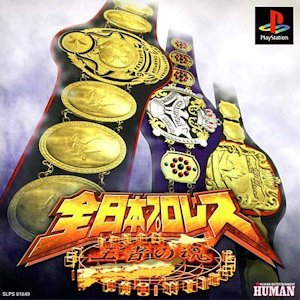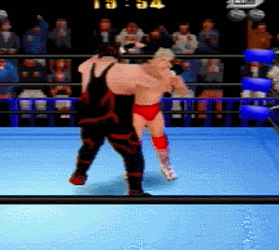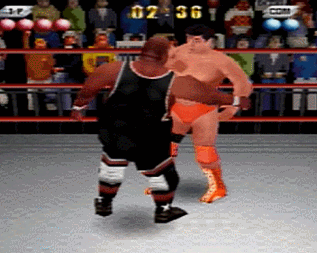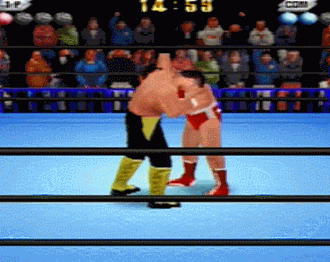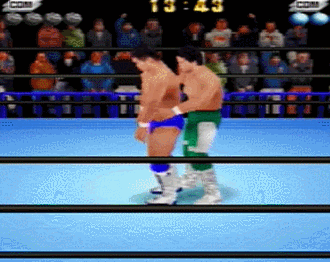
|
||||
|---|---|---|---|---|
|
Zen-Nippon Pro Wrestling: Ouja no Kon
A Puroresu Game Review by Kevin Wilson
Platform: Sony Playstation Graphics: This is a very Playstation looking game. Which shouldn't be a surprise since it came out on Playstation. What I mean by that it is a bit blocky and awkward, there are some detection issues and there will be times you 'go through' your opponent. They were still working out the kinks with 3D gameplay back then. On the flipside you'll have no issues telling who the wrestlers are at all as the faces are done pretty well (better than the N64 face models anyway) and 95% of the moves look really good. I don't think it holds the game back, but just keep in mind what you are getting yourself into as the first few years of 3D gaming were a bit rough around the edges. Also due to the 3D issue, wrestlers turn very slowly so you have to get used to not trying a strike until you've made it all the way around and are facing your opponent. The COM has no issue with this of course so it will lead to some losing early on until you get used to the turning speed and hit detection.
Controls: Zen-Nippon Pro Wrestling: Ouja no Kon had a unique system. I won't bore you with all the details, but the main difference is you can do special moves any time you want... but you are limited on how many times you can try one. Most the major wrestlers start with four 'powerballs'. You can see them in some of the GIFs and images I included. You can use the powerballs whenever you want, they are used for both special moves and as an automatic kickout. Once you use them, you can't do any more special moves and you can't automatically kick out of pins. So there is always a balance, you want to save a couple for pin kickouts but you want to use them also to finish your opponent. Definitely different and it is pretty fun. Beyond that you have your normal strikes, but the grapple system is also different as you hit one button to choose the tie-up type (chokeslam position, waistlock, headlock, etc.), then you hit another button to decide what move to do from that position. Again it takes getting used to but it feels pretty smooth once you get the hang of it. Plus it allows for a lot of different move options so no two matches feel the same. Gameplay Options: Lots and lots of game options here. Besides the normal 'exhibition' match, there is also a singles tournament, tag team tournament, a battle royal, and MVP Season mode. There is a CAW and it is fine, but not as deep as the Fire Pro games so probably not something you will dabble in unless there is a wrestler you just have to try to make to join in the fun. More than enough here to keep you entertained if you are enjoying the game.
Wrestlers Available: On one hand compared to the Fire Pro games it pales in comparison, because it only has All Japan wrestlers. But it is an extremely complete All Japan roster with both native and gaijin wrestlers, a total of 25. This includes legends such as Giant Baba, Jumbo Tsuruta, Vader, and Stan Hansen. So definitely a solid roster, but a whole lot smaller than the Fire Pro games so it is something to keep in mind. Historical Significance: Actually not much, even though it was a much talked about game in the puroresu gaming community here in the States. Playstation wrestling games were rough across the board, and while this game overcomes that with such a realistic feel of what All Japan was like, it still is a bit clunky. The Giant Gram series that would follow this game was also made by All Japan and were more fluid games. This game also came out late in the Playstation cycle, so with Playstation 2 right around the corner it didn't leave a whole lot of an impression. A fun game for sure but not one that made a huge impact on the puroresu gaming community. Overall Thoughts: I don't say this very often about games so you know I mean it - this game was actually kind of fun to Simulate. I am not a Sim guy, I like to play my games, but when it was COM against COM they didn't have the hit detection type issues and it was fun to see how they used their powerballs. They actually had pretty good strategy, as you can see in the video above. As for when I played it, I enjoyed it quite a bit too, I just wish it was a little smoother. This game feels like All Japan, remember in the late 90s All Japan was mostly a heavyweight promotion with big suplexes and big strikes which is what this game is. So I would say its a great representation of 1999 All Japan, the game was built to play exactly how the promotion was in real life. So that is a big plus. I don't think this is the best puroresu game, which is probably true for all the Playstation games, but it has a very unique grapple/special system and represents All Japan well so it is definitely worth playing if you get the chance. Back to Puroresu Game Reviews |
||||
|
